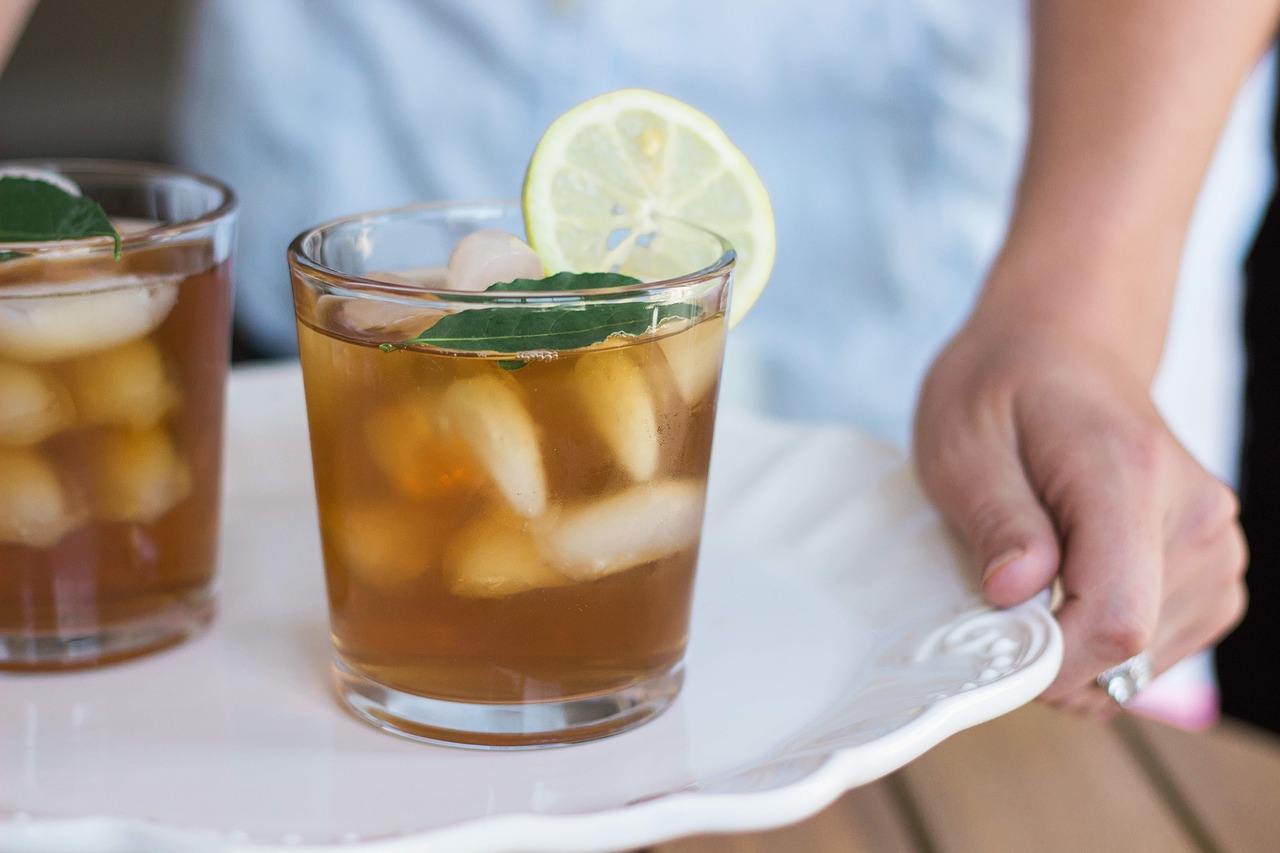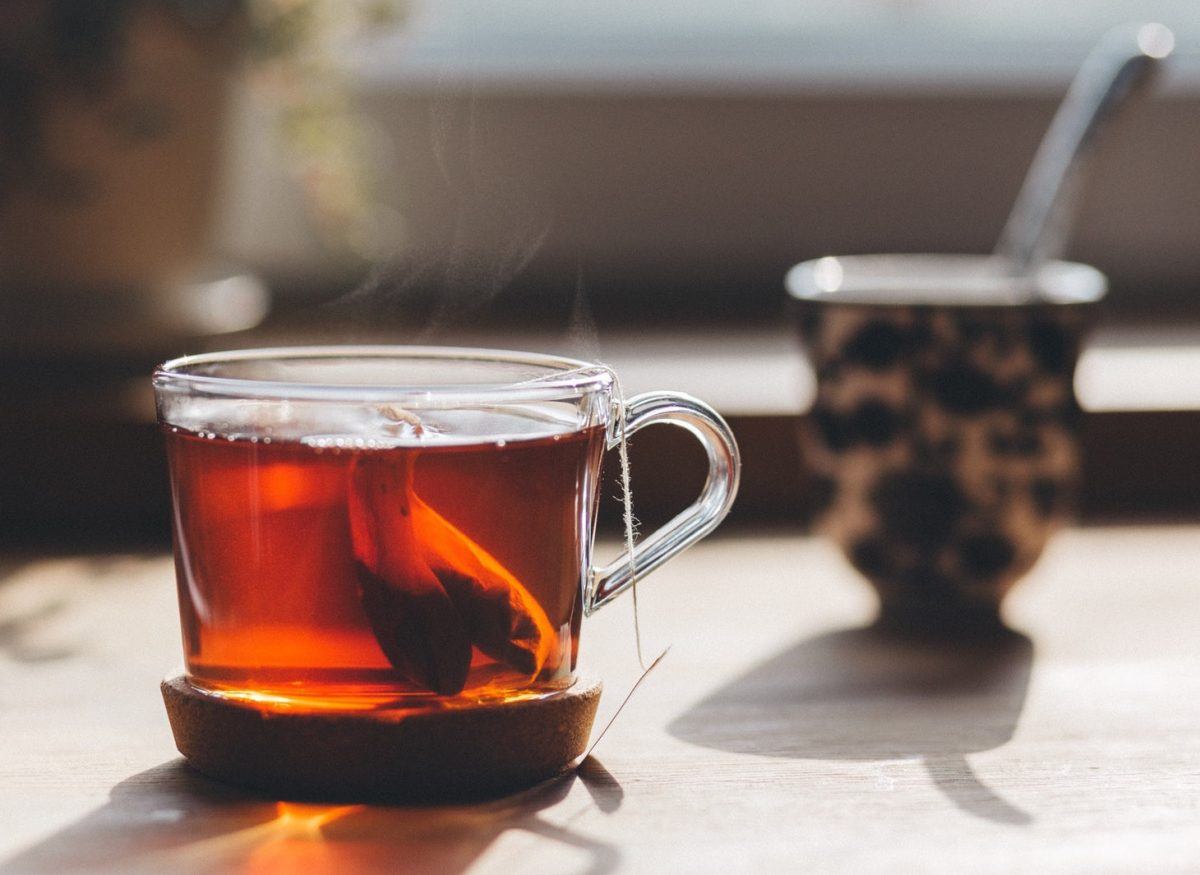Tea is the most popular beverage in the world after water. It’s a simple preparation of pouring hot water over cured leaves of the Camellia sinensis plant. The first recording of tea described it as a medicinal beverage in China in the 3rd century AD. Merchants helped its popularity to spread quickly across continents. In the early 19th century, Great Britain popularized the concept of afternoon tea, a break from one’s routine in which tea is served alongside sandwiches and baked goods such as scones. The flavor of tea varies by where the tea leaves are harvested and how they are grown and processed. Black tea is the most popular worldwide, followed by green, oolong, and white tea. [1]
Herbal teas are not made from the Camellia plant but from dried herbs, spices, flowers, fruit, seeds, roots, or leaves of other plants; they do not typically contain caffeine as do traditional teas.
Source Of
- Caffeine (traditional teas, not herbal)
- Polyphenols
- Flavonols – myricetin, quercetin, kaempferol
- Theaflavins – formed when black tea leaves are oxidized
- Catechins – found in green tea; epigallocatechin-3 gallate (EGCG) is the main form
Most traditional teas do not contain a significant amount of nutrients, but are rich in polyphenols. These are plant chemicals that give teas their distinct flavor and aroma and may have health-promoting properties.
Tea and Health
Animal studies suggest potential health benefits of tea due to its high polyphenol content. Human studies have generally been less conclusive, yet show promise. Observational research has found that tea consumption of 2-3 cups daily is associated with a reduced risk of premature death, heart disease, stroke, and type 2 diabetes. [2] However, there may be an increased risk of esophageal and stomach cancers from drinking tea that is too hot (more than 131-140° F [55-60° C]). [2,3] Randomized controlled trials are needed to confirm if these healthful and harmful associations are causal. In the meantime, there appears to be little risk associated with drinking tea except for frequent consumption of very hot tea. So pick a color, let it cool, and enjoy a cup!
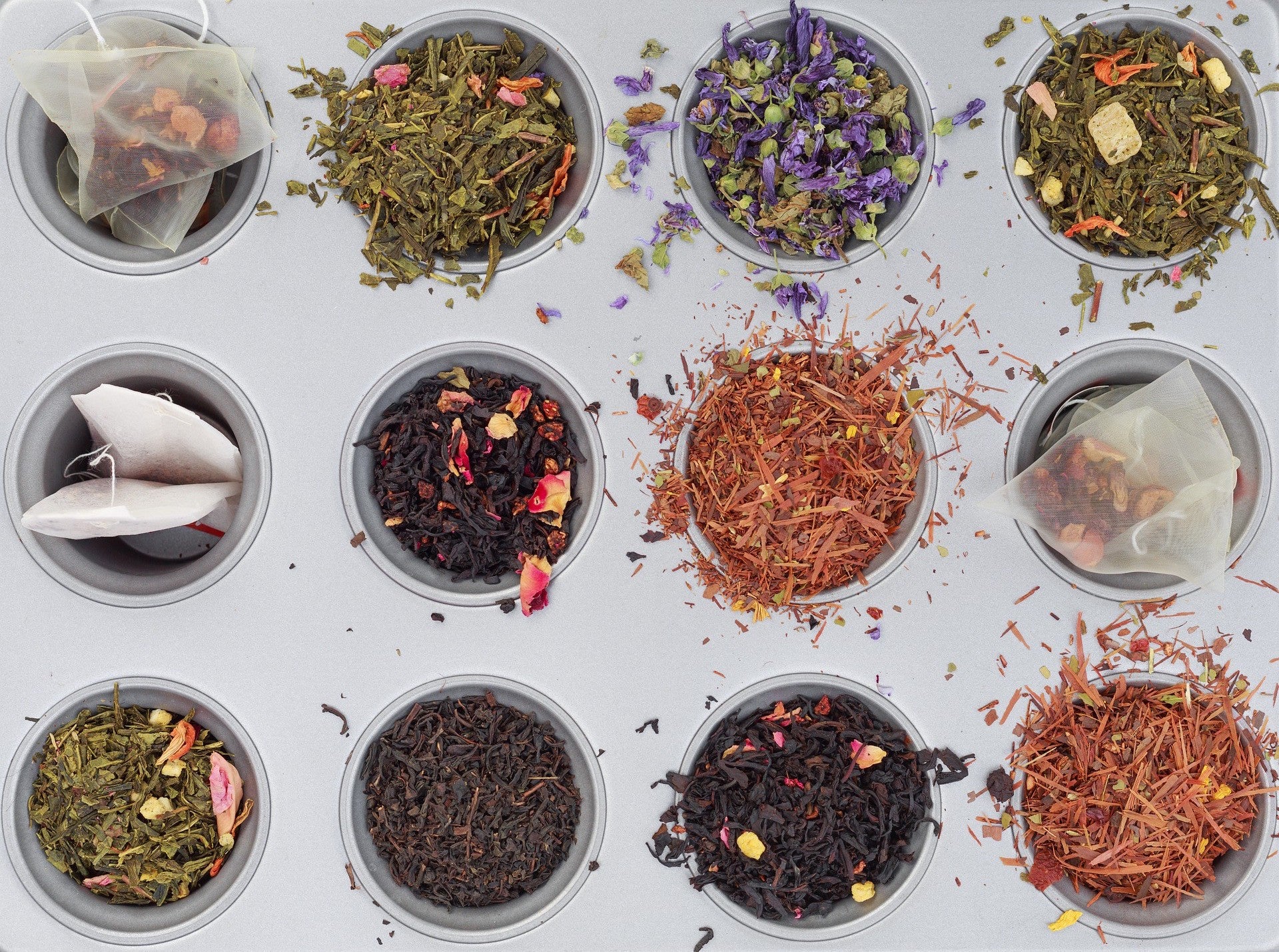
Polyphenols, or flavonoids, are likely a key component to what makes tea a healthful drink. These chemical compounds act as
antioxidants, which control the damaging effects of free radicals in the body. Free radicals can alter DNA by stealing its electrons, and this mutated DNA can increase LDL cholesterol or alter cell membrane traffic—both harmful to our health. Though green tea is often believed to be richer in polyphenols than black or oolong (red) teas, studies show that—with the exception of decaffeinated tea—all plain teas have about the same levels of these chemicals, albeit in different proportions. Green tea is richest in epigallocatechin-3 gallate whereas black tea is richest in theaflavins; research has shown that both can exert health benefits. Herbal teas contain polyphenols as well but will vary highly depending on its plant origin.
Indeed, one reason for conflicting results in observational studies may be the wide variations in tea types with varying flavonoid content. [4] Where the tea leaves are grown, the specific blend of tea leaves, type of processing, and addition of ingredients such as milk, honey, and lemon can alter specific flavonoid content. How accurately people report their tea intake (e.g., type, amount, brew strength) and their overall diet (e.g., do they eat other foods rich in flavonoids?) are other factors that need to be clarified as they can affect study results. For example:
- Some research suggests that the protein and possibly the fat in milk may reduce the antioxidant capacity of tea. [5] Flavonoids are known to “deactivate” when binding to proteins so this theory makes scientific sense. [6]
- One study that analyzed the effects of adding skimmed, semi-skimmed, and whole milk to tea concluded that skimmed milk significantly reduced the antioxidant capacity of tea. Higher-fat milks also reduced the antioxidant capacity of tea, but to a lesser degree. [7] All said, in practice it’s important to keep in mind that tea—even tea with a splash of milk—can be a healthful drink.
Learn more about some of the research on tea on health:
Cardiovascular disease
A Cochrane review found very few large, long-term studies that examined green or black tea for the primary prevention of cardiovascular disease. The authors noted that tea appears to show favorable effects on cardiovascular risk factors based on the available evidence, but this is based on only a modest number of small, short-term clinical trials so firm conclusions cannot be made. [8]
- Stroke and mortality—Polyphenols, the antioxidants abundant in tea, have been shown to reduce the risk of death due to cardiovascular disease, [9] including stroke. [7,10] In one study of 77,000 Japanese men and women, green tea and oolong tea consumption was linked with lower risk of death from cardiovascular disease. [11] Another cohort of 82,369 Japanese men and women followed for an average of 13 years found that those who drank 2-3 cups of green tea daily had a 14% reduced risk of stroke, and drinking 4 or more cups daily was associated with a 20% reduced risk. [12] Other large-scale studies show that black tea may contribute to heart health, [13] with research suggesting that drinking at least 3 cups of either black or green tea a day appears to reduce the risk of stroke by 21%. [14]
- High blood pressure—Tea flavonoids may help to keep the lining of blood vessels smooth and elastic. In a study of green and oolong tea consumption, regular consumption for one year reduced the risk of developing hypertension. [15] Long-term regular consumption of black tea has also been shown to lower blood pressure. [16] A meta-analysis that combined the results of 14 randomized controlled trials found that green tea extracts produced a small reduction in blood pressure in overweight and obese adults, though the authors noted that the trials included a small number of participants and therefore strong conclusions could not be drawn. [17]
- Cholesterol—Tea flavonoids have antioxidant properties that may prevent the oxidation of LDL cholesterol particles that could lead to inflammation and hardening of arteries. However, there is still a lack of consistent evidence in human studies showing a benefit. A meta-analysis of 15 randomized controlled trials found no significant effect of black tea on cholesterol levels (including total cholesterol, LDL and cholesterol) in both healthy subjects and people with coronary artery disease. [18] Two separate meta-analyses of randomized controlled trials looking at tea intake and cholesterol levels found that both black and green tea lowered LDL blood cholesterol levels (as measured in milligrams per decileter [mg/dL]). With green tea consumption, fasting total cholesterol and LDL cholesterol was significantly lowered by 7 mg/dL and 2 mg/dL, respectively. Black tea reduced LDL cholesterol by almost 5 mg/dL. However, the authors acknowledged that most of the studies included were of low quality, with short study durations and a small number of participants. [19,20]
Cancer
Epigallocatechin-3-gallate (EGCG) in green tea has been shown in animal and cell studies to prevent the growth of cancer cells and cause them to die. [1] Green and black tea extracts have been shown in animal studies to reduce the risk or delay the progression of cancer. [21] Green tea might also have a positive effect in reducing risk of breast, ovarian, prostate, and endometrial cancers, though evidence is limited. [22] A meta-analysis of 41 prospective studies found no decreased risk of five cancers (breast, colorectal, liver, prostate, stomach) with black tea intake (about 3 cups daily). [21] Overall, human studies about tea and cancer are limited and results are inconsistent. Learn more about cancer and antioxidants.
A positive association has been found between drinking hot tea and a greater risk of esophageal cancer. It is believed that very hot beverages may cause cell injury that could lead to cancer. [3] Studies showing this association with tea have been largely in Asia and the Middle East. There is less evidence in Western populations, where beverages including coffee and tea are usually consumed at more moderate temperatures. Westerners also may add milk or cream to very hot beverages, immediately lowering the temperature. A meta-analysis of 16 case-control studies conducted in China, India, Iran and other countries in Europe and South America found an association of increased risk of esophageal cancer with higher consumption of both very hot beverages and foods. [23] It appears that cancer risk of this type is directly linked to temperature, rather than a specific component of the food or beverage.
A large prospective study of 50,045 Iranian men and women followed for about 10 years found a 90% increased risk of esophageal cancer when comparing those drinking “very hot” versus “cold/lukewarm” tea. It also found that the shorter the time from pouring the tea into a cup to drinking it was associated with increased risk. In May 2016, after a review of available research, the International Agency for Research on Cancer (IARC) concluded that “drinking very hot beverages above 65 C (140 F)” is “probably carcinogenic.” [3] They acknowledged certain limitations of existing studies that precluded listing a “carcinogenic” label, one being that data on the actual temperature of tea are self-reported, in which the perception of “hot” may vary among ethnicities and populations.
In 2018, a large cohort study of 456,155 men and women in China followed for a median of nine years found that participants who drank burning-hot tea daily along with excessive alcohol had five times the risk of developing esophageal cancer than those who drank less of both beverages. Those who drank burning-hot tea daily and smoked tobacco had double the risk of developing this cancer. [24]
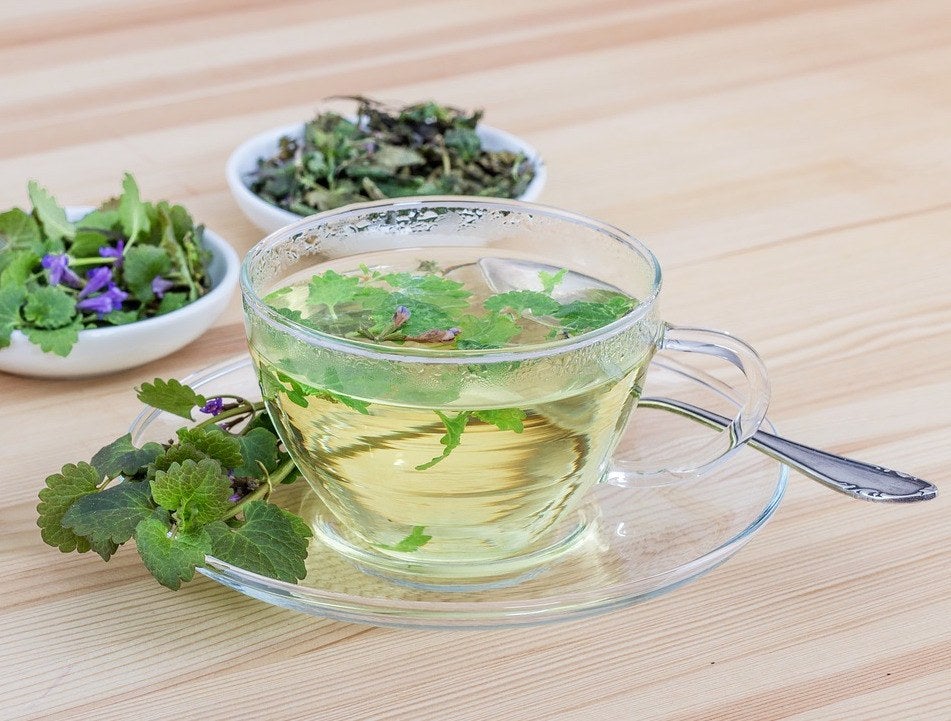
Decaffeinated tea is an option if you enjoy the flavor and experience of tea but are sensitive to caffeine. People have varying sensitivity to caffeine but it is classified as a stimulant that has the potential to affect the nervous system and heart rate, and cause jitteriness. In general, traditional teas already have about half the caffeine of coffee and even less if the brewing time is shorter.
To decaffeinate tea, there are different methods. One process uses an organic chemical solvent (either ethyl acetate or methylene chloride) that also removes most of tea’s polyphenols. The residual amount of the chemical after processing is minimal to none, and no research has shown negative health effects. Another method called “effervescence” uses water and carbon dioxide, which retains the majority of polyphenols. Both methods apply the chemical or gas onto moistened tea leaves, which bonds to the caffeine; when the leaves are dried, the caffeine evaporates along with the solvent/gas. If you wish to know which processing method is used, check the package label or contact the manufacturer.
Herbal teas are naturally caffeine-free and do not undergo a decaffeination process.
Most research looks at the health effects of traditional teas, not decaffeinated. Decaffeinated tea may lose polyphenols that are associated with health benefits, depending on the processing method. Polyphenol content varies widely among teas even before the decaffeinated process, so it is hard to know the exact amount that remains. Regardless of decaffeination type, tea is still considered a healthful beverage choice.
Purchase
If you visit a tea shop, you may be surprised and overwhelmed by just how many different teas exist! Traditional teas originating from the Camellia sinensis plant include black, white, green, yellow, and oolong, all of which contain caffeine. Black tea is made by crushing and drying fresh tea leaves and allowing them to ferment, which oxidizes the leaves and changes their color and flavor. Oolong tea is partly fermented, and green tea undergoes no fermentation. Matcha is a special form of green tea in which the dried leaves are ground into a fine powder.
Decaffeinated teas have been processed to remove most of the naturally occurring caffeine from the leaves. They may still contain trace amounts of caffeine. This is done by using carbon dioxide, ethyl acetate, methylene chloride, or water processing.
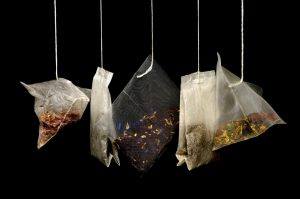 Herbal teas that are naturally caffeine-free include chamomile, peppermint, vanilla, turmeric, ginger, and fruit essence teas. They may have notes of floral, fruit, mint, spice, grassiness, sweetness, or bitterness. The varieties are vast, and the choice is completely up to your personal preferences.
Herbal teas that are naturally caffeine-free include chamomile, peppermint, vanilla, turmeric, ginger, and fruit essence teas. They may have notes of floral, fruit, mint, spice, grassiness, sweetness, or bitterness. The varieties are vast, and the choice is completely up to your personal preferences.
Teas are packaged in tea bags, tea sachets, or as loose-leaf. Loose-leaf teas sold in tin canisters or sacks allow you to control how much tea to use, using more to create a stronger flavor or less for more mellowness. Tea bags and sachets hold a standard amount of leaves for optimum flavor and are portable.
Store
There are five elements to avoid to keep tea as fresh as possible: light, heat, moisture, odor, and air. Tea bags should be stored in their original container or placed in a sealed plastic bin. Loose-leaf teas should be stored in an airtight container. Place all teas in a dark cupboard at a consistent room temperature. Tea tends to absorb odors from food and even other strongly scented teas, so keep them separate. Freezing and refrigerating is not recommended as the moisture introduced can degrade the tea.
If unopened, tea will last about one year beyond the “best by” date. After opening, packaged and loose-leaf teas last about one year. However, some black and oolong teas can last up to two years, and more delicate teas may last only 6 months. The flavor is your best guide to determining how long to keep a tea in your cupboard.
Make
Avoid purchasing expensive bottled teas or teas from shops that contain added sweeteners. To enjoy the maximum benefits of drinking tea, consider brewing your own at home. You can serve it hot, or make a pitcher of home-brewed iced tea during warmer months.
Black and oolong teas are generally steeped in hot or boiling water (about 210º F) and brewed for about 4-5 minutes. Green tea is steeped at a slightly lower temperature 180º F from 4-15 minutes. The longer tea steeps, the stronger the flavor with bitter notes.
Additives of sugar, cream, or milk can reduce the polyphenol content of tea. For the greatest health benefits, try serving tea plain or without too many additives. A dash of vanilla or cinnamon can mimic sweetness. Some fruit-flavored herbal teas taste naturally sweet to the palate without added sweeteners.
Try making this refreshing iced tea at home; the perfect sugar-free alternative to store-bought sweetened tea drinks or sodas.
Did You Know?
- What western coffeehouses commonly refer to as “chai” is more accurately called “masala chai” or “spiced tea” (“chai” is simply the Hindi word for “tea”). The recipe for this beverage has varied widely across time and place, but today is often made from black tea mixed with spices like cinnamon, cardamom, cloves, ginger, and peppercorns, and served with milk and sweetener.
- Japan has a rich tea culture, best known for the ceremonial preparation and drinking of green tea. A traditional Japanese tea ceremony, also called “the way of tea” (茶道 [sadō or chadō] or 茶の湯 [chanoyu]) can take up to multiple hours!
- Some advertisements claim that tea can speed weight loss, but research on the effects of green tea and fat reduction have shown little promise of weight loss benefits. [25,26] Moreover, it’s best to skip any so-called “weight loss” teas that may contain potentially harmful substances such as laxatives.
- Yerba mate, or mate, is a popular herbal tea in South America made from the dried leaves of the Ilex paraguariensis tree. It shares traits with coffee in that they both contain the antioxidant polyphenol chlorogenic acid and similar amounts of caffeine. There has been concern that certain processing methods of mate, such as drying the leaves with smoke, may introduce polycyclic aromatic hydrocarbons (the carcinogenic substances also found in grilled or smoked meats). [27] Some research links drinking large amounts of mate over time with increased risk of certain cancers, including head and neck, stomach, bladder, and lung, but it is not clear if the risk is due to drinking it very hot or the presence of polycyclic aromatic hydrocarbons. Therefore, mate fans may choose to drink it at moderate temperatures or to purchase brands that process it by air-drying rather than smoking.
References
- Khan N, Mukhtar H. Tea polyphenols in promotion of human health. Nutrients. 2019 Jan;11(1):39.
- Yi M, Wu X, Zhuang W, Xia L, Chen Y, Zhao R, Wan Q, Du L, Zhou Y. Tea Consumption and Health Outcomes: Umbrella Review of Meta‐Analyses of Observational Studies in Humans. Molecular Nutrition & Food Research. 2019 Jun 19:1900389.
- Loomis D, Guyton KZ, Grosse Y, Lauby-Secretan B, El Ghissassi F, Bouvard V, Benbrahim-Tallaa L, Guha N, Mattock H, Straif K. Carcinogenicity of drinking coffee, mate, and very hot beverages. The Lancet Oncology. 2016 Jul 1;17(7):877-8.
- Dwyer JT, Peterson J. Tea and flavonoids: where we are, where to go next. The American journal of clinical nutrition. 2013 Oct 30;98(6):1611S-8S.
- Ryan L, Petit S. Addition of whole, semiskimmed, and skimmed bovine milk reduces the total antioxidant capacity of black tea. Nutr Res. 2010;30:14-20.
- Arts MJ, Haenen GR, Wilms LC, et al. Interactions between flavonoids and proteins: effect on the total antioxidant capacity. J Agric Food Chem. 2002;50:1184-7.
- Hollman PC, Geelen A, Kromhout D. Dietary flavonol intake may lower stroke risk in men and women. J Nutr. 2010;140:600-4.
- Hartley L, Flowers N, Holmes J, Clarke A, Stranges S, Hooper L, Rees K. Green and black tea for the primary prevention of cardiovascular disease. Cochrane Database of Systematic Reviews. 2013(6).
- Kuriyama S, Shimazu T, Ohmori K, et al. Green tea consumption and mortality due to cardiovascular disease, cancer, and all causes in Japan: the Ohsaki study. JAMA. 2006;296:1255-65.
- Larsson SC, Virtamo J, Wolk A. Black tea consumption and risk of stroke in women and men. Ann Epidemiol. 2013;23:157-60.
- Mineharu Y, Koizumi A, Wada Y, et al. Coffee, green tea, black tea and oolong tea consumption and risk of mortality from cardiovascular disease in Japanese men and women. J Epidemiol Community Health. 2011;65:230-40.
- Kokubo Y, Iso H, Saito I, Yamagishi K, Yatsuya H, Ishihara J, Inoue M, Tsugane S. The impact of green tea and coffee consumption on the reduced risk of stroke incidence in Japanese population: the Japan public health center-based study cohort. Stroke. 2013 May;44(5):1369-74.
- Arab L, Liu W, Elashoff D. Green and black tea consumption and risk of stroke: a meta-analysis. Stroke. 2009;40:1786-92.
- Nechuta S, Shu XO, Li HL, et al. Prospective cohort study of tea consumption and risk of digestive system cancers: results from the Shanghai Women’s Health Study. Am J Clin Nutr. 2012;96:1056-63.
- Yang YC, Lu FH, Wu JS, Wu CH, Chang CJ. The protective effect of habitual tea consumption on hypertension. Arch Intern Med. 2004;164:1534-40.
- Hodgson JM, Puddey IB, Woodman RJ, et al. Effects of black tea on blood pressure: a randomized controlled trial. Arch Intern Med. 2012;172:186-8.
- Li G, Zhang Y, Thabane L, Mbuagbaw L, Liu A, Levine MA, Holbrook A. Effect of green tea supplementation on blood pressure among overweight and obese adults: a systematic review and meta-analysis. Journal of hypertension. 2015 Feb 1;33(2):243-54.
- Wang D, Chen C, Wang Y, Liu J, Lin R. Effect of black tea consumption on blood cholesterol: a meta-analysis of 15 randomized controlled trials. PLoS One. 2014 Sep 19;9(9):e107711.
- Zheng XX, Xu YL, Li SH, Liu XX, Hui R, Huang XH. Green tea intake lowers fasting serum total and LDL cholesterol in adults: a meta-analysis of 14 randomized controlled trials. The American journal of clinical nutrition. 2011 Jun 27;94(2):601-10.
- Zhao Y, Asimi S, Wu K, Zheng J, Li D. Black tea consumption and serum cholesterol concentration: Systematic review and meta-analysis of randomized controlled trials. Clinical Nutrition. 2015 Aug 1;34(4):612-9.
- Yu F, Jin Z, Jiang H, Xiang C, Tang J, Li T, He J. Tea consumption and the risk of five major cancers: a dose–response meta-analysis of prospective studies. BMC Cancer. 2014 Dec;14(1):197.
- Johnson R, Bryant S, Huntley AL. Green tea and green tea catechin extracts: an overview of the clinical evidence. Maturitas. 2012;73:280-7.
- Andrici J, Eslick GD. Hot food and beverage consumption and the risk of esophageal cancer: a meta-analysis. American journal of preventive medicine. 2015 Dec 1;49(6):952-60.
- Yu C, Tang H, Guo Y, Bian Z, Yang L, Chen Y, Tang A, Zhou X, Yang X, Chen J, Chen Z. Hot tea consumption and its interactions with alcohol and tobacco use on the risk for esophageal cancer: a population-based cohort study. Annals of internal medicine. 2018 Apr 3;168(7):489-97.
- Jurgens TM, Whelan AM, Killian L, Doucette S, Kirk S, Foy E. Green tea for weight loss and weight maintenance in overweight or obese adults. Cochrane Database Syst Rev. 2012;12:CD008650.
- Wharton S, Bonder R, Jeffery A, Christensen RA. The safety and effectiveness of commonly-marketed natural supplements for weight loss in populations with obesity: A critical review of the literature from 2006 to 2016. Critical reviews in food science and nutrition. 2019 Mar 14:1-7.
- Oranuba E, Deng H, Peng J, Dawsey SM, Kamangar F. Polycyclic aromatic hydrocarbons as a potential source of carcinogenicity of mate. Journal of Environmental Science and Health, Part C. 2019 Jan 2;37(1):26-41.
Last reviewed April 2023
Terms of Use
The contents of this website are for educational purposes and are not intended to offer personal medical advice. You should seek the advice of your physician or other qualified health provider with any questions you may have regarding a medical condition. Never disregard professional medical advice or delay in seeking it because of something you have read on this website. The Nutrition Source does not recommend or endorse any products.


 Herbal teas that are naturally caffeine-free include chamomile, peppermint, vanilla, turmeric, ginger, and fruit essence teas. They may have notes of floral, fruit, mint, spice, grassiness, sweetness, or bitterness. The varieties are vast, and the choice is completely up to your personal preferences.
Herbal teas that are naturally caffeine-free include chamomile, peppermint, vanilla, turmeric, ginger, and fruit essence teas. They may have notes of floral, fruit, mint, spice, grassiness, sweetness, or bitterness. The varieties are vast, and the choice is completely up to your personal preferences.